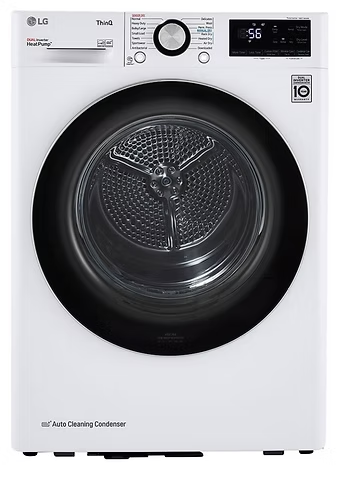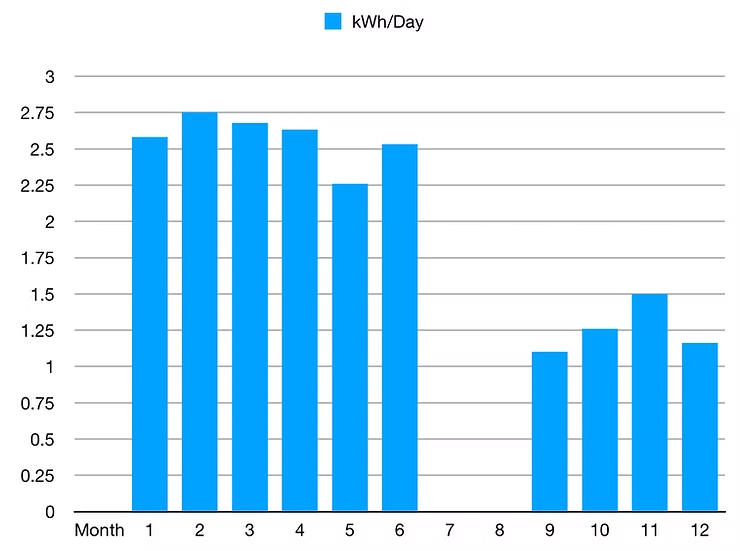
It’s time for a post on heat pump clothes dryers! First, some energy use data on our new LG unit, installed at our Charlottesville, VA home in August, 2021. Then, a whole lot of info in Q+A format. All info is with respect to the U.S. marketplace.
At the time of writing, we had 4 full months of monitored energy use data on our LG model DLHC1455, as well as 6 full months of data from our old (2007) electric exhaust dryer from earlier in 2021. June + July are not shown on the graph since we went without a dryer for most of those months, while we waited for the LG to arrive. The data is reported in kWh/day so that we can more accurately compare months to one another. So far, we’re seeing 51% less energy use per day with the new heat pump clothes dryer. For our 4-person household, this extrapolates out to 480kWh/year energy savings at a cost savings of about $60/yr.

What the heck is a heat pump clothes dryer?
A video is worth more than 1,000 words. Check out the vids from Ask This Old House: https://www.youtube.com/watch?v=DeN-h6opueM or from Miele: https://www.youtube.com/watch?app=desktop&v=3M9iNQ2rPFU These are efficient, electric, ventless, tumble clothes dryers.
How long do they take to dry the clothes? Our experience: Plan on 90-120 minutes for most loads…~50%+ longer than a standard exhaust dryer. We rarely do a bunch of loads back to back at our house, so the longer drying time doesn’t impact our schedule.
Who sells them in the U.S.? Miele, LG, Samsung, Bosch, Asko, Blomberg/Beko, Whirlpool, Insignia (Best Buy house brand by Midea)
How much do they cost? Right now, heat pump dryers range from ~$900-$2,000. For comparison, standard electric exhaust dryers currently range from ~$450-$2,000.
How long have heat pump dryers been around? Since 1997, according to: https://www.osti.gov/servlets/purl/1022740
How efficient are they? 1.5x to 3x more efficient than a standard electric exhaust dryer.
That’s a big range. How can I compare efficiency across models?
Use the Energy Star product finder: https://t.co/WRiwBDWYal Filter by “Heat Pump Technology”* *the Midea / Insignia heat pump model doesn’t currently show up with this filter.
Where does the water/moisture from my clothes go?
The heat pump system condenses the water vapor from the drum into liquid water. It is then pumped out of the machine by a small water pump, typically using a 1/4” plastic drain hose that is inserted into the same drain receptacle as the washing machine. New drain plumbing is not usually needed, if you already have a washing machine and drain.
How much heat do they add to the room?
Not much as you might think!* They radiate heat from the cabinet into the room, just like regular exhaust dryers. For the LG model, that’s all the heat. For the Miele + Blomberg/Beko models (maybe others as well), they have a “desuperheater” function near the end of the drying cycle in order to protect the compressor. A small amount of heat from the heat pump circuit is diverted to the room during the last ~20-30 minutes.
*Some of the Whirlpool models include an electric resistance heating element that may engage, depending on the setting. The room heat gain, in this case, can be significant. What are the electrical power requirements?
These vary by manufacturer. If you have limited panel space and/or electrical service capacity, the Miele, Insignia/Midea or Bosch models look to be better in that respect. LG 240V, 30A circuit breaker
Miele 120V, 15A circuit breaker
Blomberg / Beko 240V, 30A circuit breaker, but the matching washer just plugs into the dryer…so only a single circuit breaker is needed for the washer+ dryer together!
Insignia / Midea 240V, 10A circuit breaker
Whirlpool 240V / 30A circuit breaker Bosch 240V, 10A circuit breaker
Samsung 240V, 30A circuit breaker
What are the maintenance requirements for heat pump dryers?
These vary by manufacturer. I’m including a summary of my LG model just for reference: 1) Clean the main filter after every cycle
2) Clean the secondary filter every 10 cycles (there’s a chime alert for this)
3) Wipe the moisture sensor inside the drum every now and then (I’ll do this 3-4 times per year)
4) Vacuum the cool air inlet grille at the back of the unit 3-4 times per year. Good luck with this if your dryer (like mine) is in a tight installation.
5) If you don’t use the dryer much, follow the instructions to drain the remaining condensed water and/or use the “Drum Care” feature to remove/prevent odors in the drum
6) LG claims that built up lint is automatically cleaned from the “condenser” heat exchange coil, using water condensed from the drying process. You can also run the “Condenser Care” feature every now and then to give this process a boost. LG also says you can clean the coil manually, but doesn’t provide instructions on how to do this!
Are heat pump dryers gentler on clothes? Maybe. The lower drum temperatures might yield less wear and tear on clothes, but I don’t know of any kind of formal study. Let us know if you know of one!
What kind of refrigerant does a heat pump dryers use?
This is a bit of a mystery for the products available in the U.S. I haven’t seen any of the manufacturers list the refrigerant used, and you probably have to open up the cabinet and dig into the heat pump circuit to find out. I haven’t done this yet. It seems to me that the manufacturers think that Americans don’t care about the global warming potential (GWP) of refrigerants (read more at Project Drawdown: https://drawdown.org/solutions/refrigerant-managementi). Conversely, if you are researching heat pump dryers in the UK or EU, for example, the refrigerant type is published in the specs, and is sometimes touted, if it’s a low/er GWP refrigerant.
How long do heat pump dryers last?
We’ll see! If anyone out there has had a heat pump dryer in the U.S. for longer than 10 years, let us know what make and model you have!
Can I get a “big” heat pump dryer? Yes, but….the only “full size” models available in the U.S. right now are from Whirlpool. The user experience so far with the older Whirlpool models has been less than stellar. I hope they improved with the new models. Our “compact”* LG serves our 4-person household well, though we spread out our laundry cycles throughout the week.
*Compact in the U.S. means standard size for most of the rest of the world.

